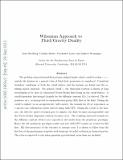| dc.contributor.author | Bredberg, Irene | |
| dc.contributor.author | Keeler, Cynthia | |
| dc.contributor.author | Lysov, Vyacheslav | |
| dc.contributor.author | Strominger, Andrew E. | |
| dc.date.accessioned | 2012-02-10T21:00:08Z | |
| dc.date.issued | 2011 | |
| dc.identifier.citation | Bredberg, Irene, Cynthia Keeler, Vyacheslav Lysov, and Andrew E. Strominger. 2011. Wilsonian approach to fluid/gravity duality. Journal of High Energy Physics 2011(3): 141. | en_US |
| dc.identifier.issn | 1029-8479 | en_US |
| dc.identifier.uri | http://nrs.harvard.edu/urn-3:HUL.InstRepos:8156523 | |
| dc.description.abstract | The problem of gravitational fluctuations confined inside a finite cutoff at radius \(r=r_c\) outside the horizon in a general class of black hole geometries is considered. Consistent boundary conditions at both the cutoff surface and the horizon are found and the resulting modes analyzed. For general cutoff \(r_c\) the dispersion relation is shown at long wavelengths to be that of a linearized Navier-Stokes fluid living on the cutoff surface. A cutoff-dependent line-integral formula for the diffusion constant \(D(r_c)\) is derived. The dependence on \(r_c\) is interpreted as renormalization group (RG) flow in the fluid. Taking the cutoff to infinity in an asymptotically AdS context, the formula for \(D(\infty)\) reproduces as a special case well-known results derived using AdS/CFT. Taking the cutoff to the horizon, the effective speed of sound goes to infinity, the fluid becomes incompressible and the Navier-Stokes dispersion relation becomes exact. The resulting universal formula for the diffusion constant \(D(horizon)\) reproduces old results from the membrane paradigm. Hence the old membrane paradigm results and new AdS/CFT results are related by RG flow. RG flow-invariance of the viscosity to entropy ratio \(\frac{\eta} {s}\) is shown to follow from the first law of thermodynamics together with isentropy of radial evolution in classical gravity. The ratio is expected to run when quantum gravitational corrections are included. | en_US |
| dc.description.sponsorship | Physics | en_US |
| dc.language.iso | en_US | en_US |
| dc.publisher | Springer | en_US |
| dc.relation.isversionof | doi:10.1007/JHEP03(2011)141 | en_US |
| dc.relation.hasversion | http://arxiv.org/abs/1006.1902 | en_US |
| dash.license | OAP | |
| dc.subject | high energy physics theory | en_US |
| dc.subject | classical theories of gravity | en_US |
| dc.subject | black holes | en_US |
| dc.subject | quantum cosmology | en_US |
| dc.subject | general relativity | en_US |
| dc.subject | AdS/CMT | en_US |
| dc.subject | holography | en_US |
| dc.subject | condensed matter physics | en_US |
| dc.title | Wilsonian Approach to Fluid/Gravity Duality | en_US |
| dc.type | Journal Article | en_US |
| dc.description.version | Author's Original | en_US |
| dc.relation.journal | Journal of High Energy Physics | en_US |
| dash.depositing.author | Strominger, Andrew E. | |
| dc.date.available | 2012-02-10T21:00:08Z | |
| dc.identifier.doi | 10.1007/JHEP03(2011)141 | * |
| dash.contributor.affiliated | Strominger, Andrew | |
| dash.contributor.affiliated | Lysov, Vyacheslav | |
| dash.contributor.affiliated | Bredberg, Irene | |


